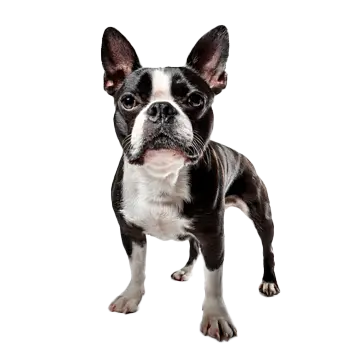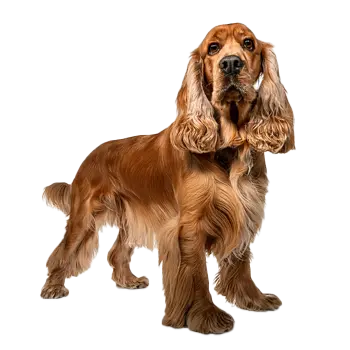Boston Spaniel
Hybrid Breed Description
The Boston Spaniel is a cross between the Boston Terrier and the Cocker Spaniel. Because each hybrid inherits a unique combination of traits from both parents, we recommend thoroughly researching both breeds before choosing a Boston Spaniel. Pay special attention to temperament, health issues, and care requirements, as your dog may express characteristics from either parent breed.
Boston Terrier

The Boston Terrier presents as a compact and well-proportioned small dog, classified within three distinct weight categories ranging from under fifteen pounds to twenty-five pounds at maturity. Standing between thirteen and seventeen inches tall at the shoulder, these dogs possess a sturdy, muscular build that belies their modest size. Their frame features a broad chest, strong straight legs set moderately apart, and a level back that contributes to their balanced appearance. The breed exhibits a characteristic square-shaped head that sits atop a slightly arched neck, with a flat skull and well-defined stop creating their distinctive profile. The most recognizable feature of this breed involves their striking coat pattern and coloration. Boston Terriers display a smooth, short coat marked with white portions distributed across a base of black, brindle, or seal coloring. Required markings include a white chest, white muzzle band, and white blaze between the eyes, often creating the appearance of formal attire that has earned them the nickname American Gentleman. Their large, round, dark eyes set widely apart convey an alert and intelligent expression, while their small, erect ears stand naturally in a bat-like position. The breed possesses a short, square muzzle with a black nose and naturally short tail that may appear straight or slightly curved. As a brachycephalic breed, Boston Terriers feature a shortened muzzle and pushed-in facial structure, contributing to their unique appearance but also requiring special considerations. Their compact size combined with a well-muscled body creates an athletic yet refined silhouette. The breed maintains clean lines throughout their structure, from their moderately sized paws to their tapered tail, presenting an overall picture of elegance and strength in miniature form.
Key Characteristics
Boston Terriers demonstrate a gentle disposition combined with an enthusiastic and affectionate personality. These dogs typically exhibit a happy-go-lucky attitude with a characteristically merry sense of humor that endears them to families. Their strong desire to please their owners makes them generally responsive to training, though they possess enough intelligence to occasionally display independent thinking. The breed shows remarkable devotion to their human companions, often forming deep bonds with family members and thriving on close interaction. Despite their small stature, they carry themselves with confidence and display a lively, spirited nature that keeps households entertained. The social nature of Boston Terriers extends to their interactions with children, elderly individuals, and other pets when properly socialized. They generally maintain a sensible approach to vocalization, barking primarily when necessary rather than becoming nuisance barkers, which makes them well-suited for apartment living. Their moderate energy level requires regular exercise through daily walks and play sessions, though they adapt well to various living situations. Boston Terriers can be protective of their owners, potentially leading to territorial behavior toward strangers or unfamiliar animals if not adequately socialized. Their sensitive temperament responds best to gentle, positive training methods rather than harsh corrections. These intelligent dogs enjoy mental stimulation and can excel in various canine sports including obedience, agility, and rally when given proper guidance. Their playful disposition persists throughout their lives, maintaining a puppy-like enthusiasm even into their senior years. Boston Terriers require consistent companionship and may develop separation anxiety if left alone for extended periods, as they genuinely prefer being involved in all family activities and following their owners from room to room throughout the day.
Boston Terriers face several breed-specific health concerns that owners should monitor throughout the dog's life. As brachycephalic dogs with shortened airways, they commonly experience respiratory challenges including stenotic nares, elongated soft palates, and everted laryngeal saccules that collectively contribute to breathing difficulties. This anatomical structure makes them particularly sensitive to heat and humidity, requiring careful monitoring during warm weather and limiting strenuous exercise in hot conditions. The breed frequently requires cesarean sections for birthing, with over eighty percent of litters delivered surgically due to the puppies' large heads relative to the mother's pelvis. Eye health represents another significant concern for Boston Terriers, with their prominent eyes making them susceptible to corneal ulcers, cataracts developing as early as eight weeks of age, and cherry eye. Regular veterinary eye examinations help detect these conditions early, allowing for timely intervention. Patellar luxation, where the kneecap slips out of position, affects many Boston Terriers and ranges from mild cases requiring only medication to severe instances necessitating surgical correction. Some dogs within the breed experience hemivertebrae, a spinal malformation that can lead to neurological problems if the misshapen vertebrae compress the spinal cord. Hereditary deafness in one or both ears occurs in certain bloodlines and requires early detection through proper testing. Additional health considerations include potential skin allergies manifesting as allergic dermatitis, which may require dietary management and topical treatments. The breed can develop heart murmurs and other cardiac issues, particularly as they age, making regular veterinary check-ups essential. Responsible breeders screen for these genetic conditions, but prospective owners should be prepared for potential health management throughout their Boston Terrier's life. The breed typically enjoys a lifespan of eleven to fifteen years when provided with appropriate care, proper nutrition, and regular veterinary attention.
Cocker Spaniel

The Cocker Spaniel stands as the smallest member of the sporting dog group, with males typically reaching fifteen inches in height at the shoulder and females measuring approximately fourteen inches tall. Adults generally weigh between twenty and thirty pounds, presenting a compact yet athletic build that reflects their heritage as hunting companions. The breed displays a well-balanced, sturdy body with a broad chest, straight legs, and a back that slopes gently toward the tail, creating their characteristic regal appearance. Their body structure combines strength with agility, enabling them to move with purpose and grace. The breed's most distinctive features include their long, silky coat with abundant feathering on the ears, legs, chest, and underside. This luxurious coat appears in numerous color variations including solid blacks, reds, tans, and golds, as well as bicolored and tricolored patterns featuring combinations of black, white, tan, orange, liver, and lemon. The Cocker Spaniel's round, graceful head features a broad, square muzzle and large, dark, expressive eyes that convey intelligence and warmth. Their long, low-set ears hang down with heavy feathering, framing the face and contributing significantly to their gentle, appealing expression. The tail, traditionally docked though increasingly left natural, carries with moderate curve and lively action. Cocker Spaniels possess a refined yet substantial bone structure that supports their active lifestyle without appearing heavy or coarse. Their medium-length neck flows smoothly into well-laid shoulders, while their hindquarters provide strong propulsion for their characteristic flowing gait. The breed's overall appearance balances elegance with functionality, maintaining the physical capabilities needed for their original sporting purpose while adapting to their modern role as beloved companions. Their silky, flowing coat requires consistent maintenance to preserve its beauty and prevent matting, particularly in the heavily feathered areas.
Key Characteristics
Cocker Spaniels exhibit a sweet, gentle temperament that has earned them enduring popularity as family companions. These dogs display remarkable affection toward their families, forming strong bonds and thriving on human interaction and attention. Their friendly, outgoing nature extends to strangers, other dogs, and various pets when properly socialized, making them excellent additions to diverse households. The breed maintains an enthusiastic, playful spirit with boundless energy that requires regular outlets through exercise and interactive play. Their eagerness to please combined with high intelligence makes them generally responsive to training, though they can occasionally display stubbornness that requires patient, consistent guidance. The breed's sociable personality means they genuinely enjoy being involved in all family activities and may struggle with extended periods of isolation. Cocker Spaniels demonstrate particular gentleness with children when raised together, though their exuberance during play requires supervision with very young children. Their moderate to high energy levels demand daily exercise including walks, play sessions, and mental stimulation to maintain their physical health and prevent behavioral issues stemming from boredom. Despite their friendly demeanor, some individuals may bark to alert their families of visitors or unusual situations, though excessive vocalization can be managed through proper training. Their sensitive nature responds poorly to harsh corrections, thriving instead under positive reinforcement methods. These intelligent dogs excel in various canine activities including obedience, agility, and field work when given appropriate outlets for their natural abilities. Their strong attachment to their owners means they follow family members throughout the home and prefer constant companionship. Cocker Spaniels may develop separation anxiety if left alone frequently or for long durations, potentially manifesting through destructive behaviors or excessive barking. The breed's gentle, affectionate character combined with their playful energy makes them adaptable to various living situations provided their exercise and companionship needs receive adequate attention throughout their lives.
Cocker Spaniels face numerous breed-specific health challenges that require diligent monitoring and preventive care. Ear infections represent one of the most common problems, with their long, floppy ears creating an environment that traps moisture and debris, promoting bacterial and yeast growth. Regular cleaning and thorough drying after swimming or bathing proves essential for preventing chronic ear issues that may eventually necessitate surgical intervention in severe cases. Progressive retinal atrophy, an inherited degenerative eye condition, leads to gradual vision loss and eventual blindness, while hereditary cataracts appear as cloudy spots that progressively impair sight. Additional eye concerns include glaucoma, dry eye, and cherry eye, all requiring prompt veterinary attention. Joint and skeletal problems affect many Cocker Spaniels throughout their lives, with hip dysplasia causing improper development of the hip socket that leads to arthritis and mobility issues. Patellar luxation, where the kneecap dislocates from its normal position, creates intermittent lameness and may require surgical correction in advanced cases. Intervertebral disc disease can cause sudden paralysis or severe pain when spinal discs rupture and compress the spinal cord. The breed also experiences elbow dysplasia, which affects the proper formation of the elbow joint and contributes to chronic pain and arthritis. These orthopedic conditions often stem from genetic predisposition, emphasizing the importance of obtaining puppies from health-tested parents. Cocker Spaniels demonstrate increased susceptibility to several systemic health issues including autoimmune disorders such as immune-mediated thrombocytopenia, which causes dangerous drops in blood platelet levels. Heart disease, particularly dilated cardiomyopathy, affects the breed and may progress silently until advanced stages. Skin allergies manifest as itching, hot spots, and infections requiring dietary management and medical treatment. Dental disease develops frequently due to crowding in their mouths, necessitating regular professional cleanings and home care. The breed typically lives fourteen to sixteen years when provided with appropriate veterinary care, proper nutrition, consistent exercise, and attentive management of their various health predispositions throughout their lifespan.
Important to Remember
Each hybrid dog is unique and may inherit any combination of traits from either parent breed. The information above represents the characteristics of the purebred parent breeds. Your Boston Spaniel may favor one parent over the other or display a blend of both. We strongly encourage you to read the complete breed profiles for both the Boston Terrier and Cocker Spaniel to fully understand the range of possible temperaments, health concerns, and care requirements.